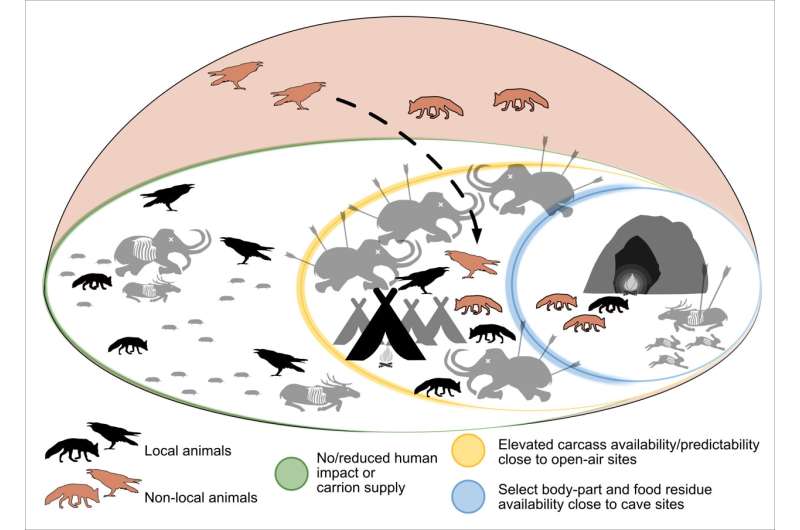This article has been reviewed according to Science X's editorial process and policies. Editors have highlighted the following attributes while ensuring the content's credibility:
fact-checked
peer-reviewed publication
trusted source
proofread
Study reveals that ravens were attracted to humans' food more than 30,000 years ago

University of Tübingen and the Senckenberg Centre for Human Evolution and Palaeoenvironment team investigates human-raven relationships
Wild animals entered into diverse relationships with humans long before the first settlements were established in the Neolithic period around 10,000 years ago. An international study by researchers from the Universities of Tübingen, Helsinki and Aarhus presents new evidence that ravens helped themselves to people's scraps and picked over mammoth carcasses left by human hunters during the Pavlovian culture more than 30,000 years ago in what is now Moravia in the Czech Republic.
The large number of raven bones found at the sites suggests that the birds in turn were a supplementary source of food, and may have become important in the culture and worldview of these people.
The study's lead authors are Dr. Chris Baumann, who currently conducts research at the Universities of Tübingen and Helsinki, and Dr. Shumon T. Hussain from Aarhus University, an expert in the deep history of human-animal interaction, along with Professor Hervé Bocherens of the University of Tübingen and the Senckenberg Centre for Human Evolution and Palaeoenvironment. The study has been published in the journal Nature Ecology and Evolution.
In an earlier study, published in Archaeological and Anthropological Sciences, Chris Baumann described a general framework for the study showing that animal-human coexistence goes back deep into the Pleistocene. In it, he argued that such relationships likely shaped early ecosystems.
A similar food spectrum
Ravens have a very wide food spectrum, are curious and flexible in their behavior. Their bones were discovered in large numbers at the archaeological sites of Předmostí, Pavlov I, and Dolní Věstonice I in southern Moravia. "The number of raven remains at these sites is remarkable and very unusual for the time period," says Shumon T. Hussain.
The researchers suspected that the ravens were living close to humans, perhaps attracted by their settlement activities. The research team examined the bones of twelve common ravens from the sites and determined the birds' diet by analyzing the nitrogen, carbon and sulfur stable isotope compositions in the bones.
"These ravens fed predominantly on the meat of large herbivores, often mammoth, much like humans did at the time," Chris Baumann explains. "We draw the conclusion that they were attracted to mammoth carcasses available near human camps."
According to the team, the animals' behavior was oriented toward what humans were doing in their environment. They say humans, in turn, took advantage of it, catching ravens, possibly for their feathers and meat. Such evidence is important for understanding early hunter-gatherer ecosystems. The researchers propose that raven behavior was synanthropic, which means that the birds benefited from a shared ecosystem with human hunter-gatherers.
The myth of pristine nature
"It is often assumed that early human foragers lived in and with a practically untouched natural environment. However, this is certainly too simple. We now know that human behavior impacted and changed ecosystems at least 30,000 years ago and that this had important effects for other organisms," says Chris Baumann.
Food scraps left by humans provided a stable food base for small scavengers, and enabled novel human-adapted feeding niches to emerge. Such niches were exploited progressively upon over time and likely became key for some species, he says. At the same time, the respective animals became more important for human cultures. A possible side-effect of these developments was the increased likelihood of zoonoses—infectious diseases which can be transmitted between humans and animals.
More information: Chris Baumann et al, Evidence for hunter-gatherer impacts on raven diet and ecology in the Gravettian of Southern Moravia. Nature Ecology and Evolution. DOI: 10.1038/s41559-023-02107-8. www.nature.com/articles/s41559-023-02107-8
Chris Baumann, The paleo-synanthropic niche: a first attempt to define animal's adaptation to a human-made micro-environment in the Late Pleistocene, Archaeological and Anthropological Sciences (2023). DOI: 10.1007/s12520-023-01764-x
Journal information: Nature Ecology & Evolution
Provided by University of Tübingen





















